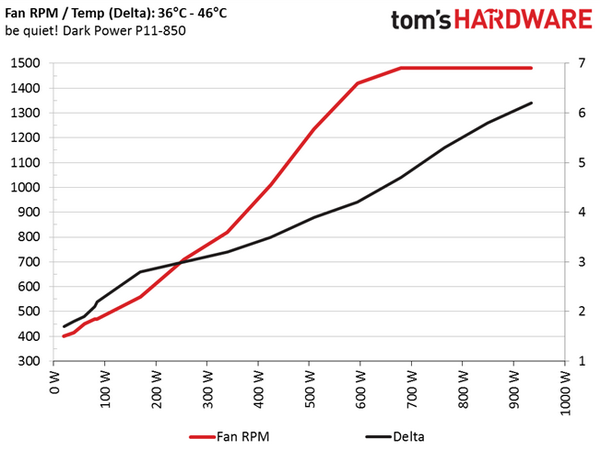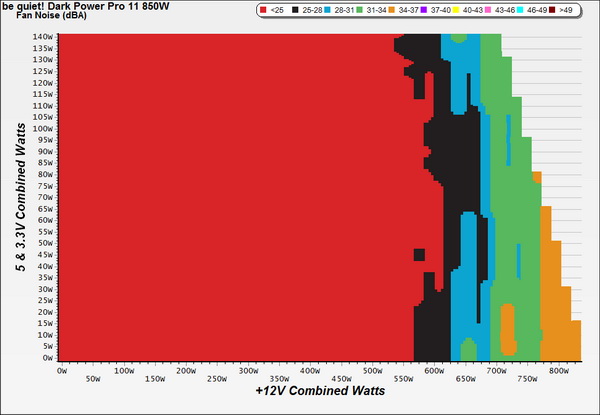be quiet! Dark Power Pro 11 850W Power Supply Review
Why you can trust Tom's Hardware
Efficiency, Temperatures And Noise
Efficiency
Our efficiency testing procedure is detailed here.
Using the previous page's results, we plotted a chart showing the efficiency of the Dark Power P11-850 at low loads, and at loads equal to 10 to 110 percent of the PSU's maximum rated capacity.
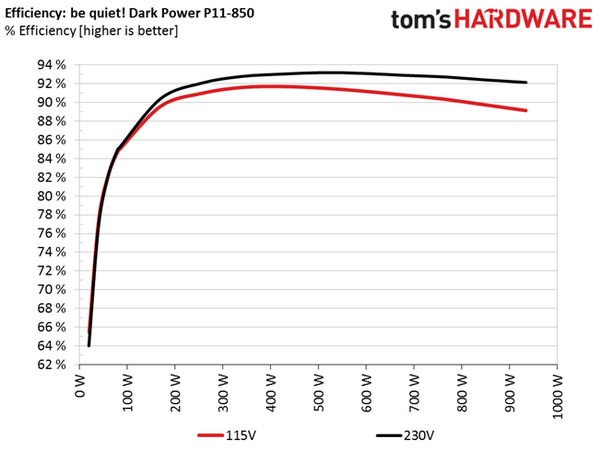
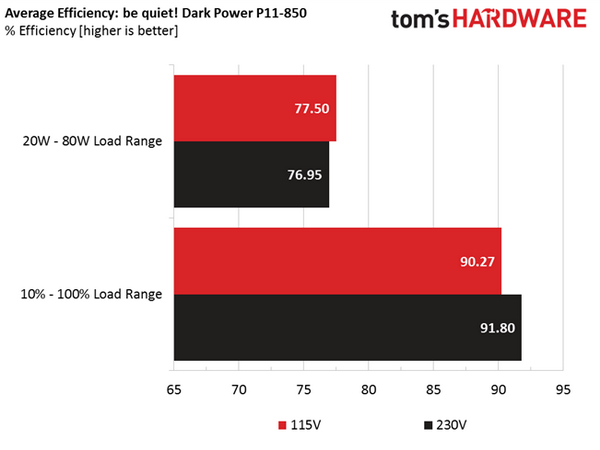
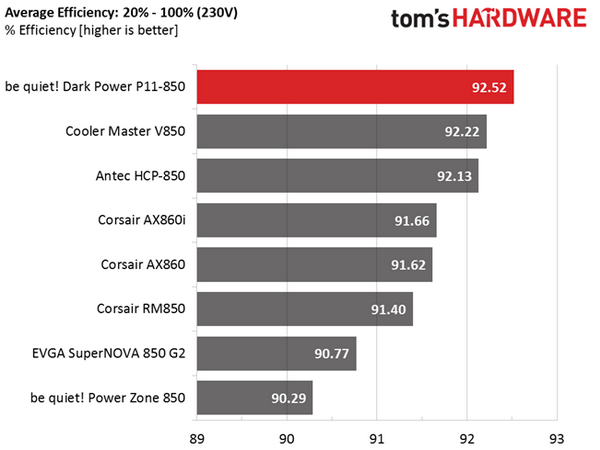
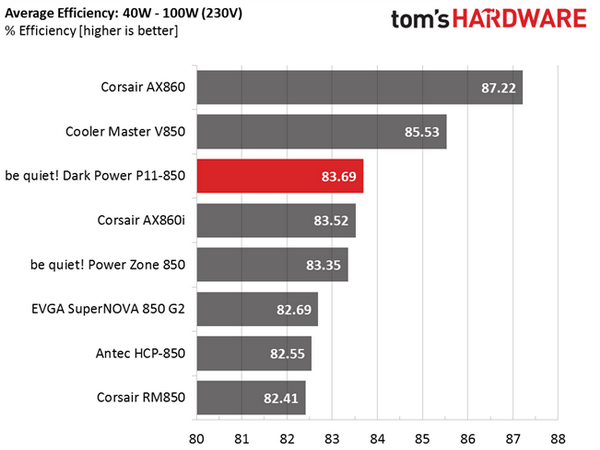
The Dark Power P11-850 took the lead in efficiency performance over all the competing PSUs under normal loads, including Corsair's AX860 and AX860i, which many consider among the best in this wattage category. Under light loads, the PSU performed pretty well, though it fell behind the Seasonic implementations (Corsair AX860 and Cooler Master V850).
Efficiency At Low Loads
In the next tests, we measure the efficiency of the Dark Power P11-850 at loads significantly lower than 10 percent of the device's maximum capacity (the lowest load the 80 PLUS standard measures). The loads we dialed were 20, 40, 60 and 80W. This is important for representing when a PC is idle, with power-saving features turned on.
| Test | 12V | 5V | 3.3V | 5VSB | PowerDC/AC(W) | Efficiency(%) | FanSpeed(RPM) | FanNoisedB(A) | PF/AC(V) |
|---|---|---|---|---|---|---|---|---|---|
| 1 | 1.205A | 0.491A | 0.480A | 0.192A | 19.68 | 65.47 | 400 | 18.7 | 0.865 |
| 12.114V | 5.083V | 3.330V | 5.130V | 30.06 | 114.9 | ||||
| 2 | 2.434A | 0.978A | 0.990A | 0.390A | 39.74 | 77.45 | 415 | 18.8 | 0.938 |
| 12.112V | 5.080V | 3.328V | 5.121V | 51.31 | 115.0 | ||||
| 3 | 3.670A | 1.465A | 1.501A | 0.585A | 59.86 | 82.28 | 450 | 19.1 | 0.962 |
| 12.111V | 5.076V | 3.324V | 5.113V | 72.75 | 115.0 | ||||
| 4 | 4.887A | 1.973A | 1.985A | 0.780A | 79.76 | 84.80 | 470 | 19.7 | 0.972 |
| 12.109V | 5.073V | 3.321V | 5.102V | 94.06 | 115.0 |
The Dark Power Pro 11 delivered high efficiency levels at light loads, with two out of the four tests easily exceeding the 80-percent mark. In addition, the output noise was almost inaudible.
5VSB Efficiency
The ATX specification states that 5VSB standby supply efficiency should be as high as possible, recommending 50 percent or higher efficiency with a 100mA load, 60 percent or higher with a 250mA load and 70 percent or higher with a 1A or higher load.
We will take four measurements: one each at 100, 250 and 1000mA, and one with the full load the 5VSB rail can handle.
Get Tom's Hardware's best news and in-depth reviews, straight to your inbox.
| Test | 5VSB | Power DC/AC(W) | Efficiency(%) | PF/AC(V) |
|---|---|---|---|---|
| 1 | 0.101A | 0.52 | 67.53 | 0.063 |
| 5.137V | 0.77 | 115.1 | ||
| 2 | 0.251A | 1.29 | 73.30 | 0.135 |
| 5.131V | 1.76 | 115.2 | ||
| 3 | 1.002A | 5.11 | 78.37 | 0.321 |
| 5.103V | 6.52 | 115.0 | ||
| 4 | 3.002A | 15.10 | 76.77 | 0.447 |
| 5.031V | 19.67 | 115.0 |
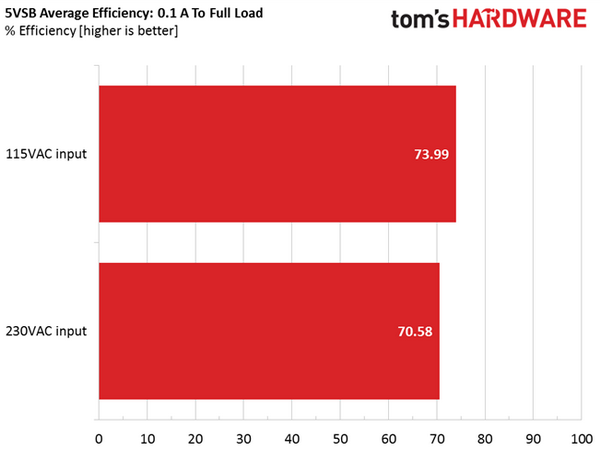

The 5VSB rail wasn't so efficient. At 115V input, we would like to see at least one reading above 80 percent. At 230V, this PSU fell to the bottom of the pack.
Power Consumption In Idle And Standby
| Mode | 12V | 5V | 3.3V | 5V | Power AC(W) | PF/AC(V) |
|---|---|---|---|---|---|---|
| Idle | 12.125V | 5.083V | 3.334V | 5.139V | 10.96 | 0.563 |
| 115.1 | ||||||
| Standby | 0.08 | 0.007 | ||||
| 115.1 |

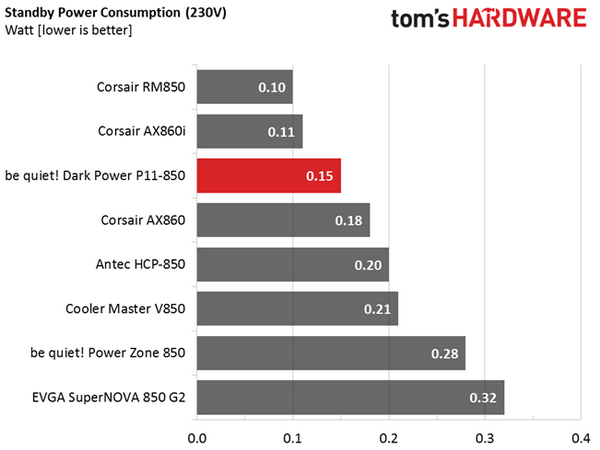
In the table above, you find the power consumption and voltage values of all rails (except -12V) when the PSU is in idle mode (powered on, but without any load on its rails). You also find the power consumption when the PSU is in standby mode (without any load at 5VSB).
Power consumption at idle was low, with both 115V and 230V input.
Fan RPM, Delta Temperature And Output Noise
Our mixed noise testing is described in detail here.
The following chart illustrates the cooling fan's speed (RPMs) and the delta between input and output temperature. The results were obtained at 36 degrees C to 46 degrees C ambient temperature.
The next chart shows the cooling fan's speed (RPMs) and output noise. We measured acoustics from one meter away inside of a small, custom-made anechoic chamber with internals completely covered in soundproofing material (be quiet! Noise Absorber kit). Background noise inside the anechoic chamber was below 18 dB(A) during testing, and the results were obtained with the PSU operating at 36 degrees C to 46 degrees C ambient temperature.
The following graph illustrates the fan's output noise over the entire operating range of the PSU. The same conditions of the above graph apply to our measurements, though the ambient temperature was between 28 degrees C and 30 degrees C.
At normal conditions, the PSU is dead silent, as you can see from the graph above. Even with full load, the noise that the PSU's fan outputs is within the 31-34 dB(A) region, a low level for a 850W PSU.
Current page: Efficiency, Temperatures And Noise
Prev Page Load Regulation, Hold-Up Time And Inrush Current Next Page Cross-Load Tests And Infrared Images
Aris Mpitziopoulos is a contributing editor at Tom's Hardware, covering PSUs.
-
Xivilain For lower wattage units, I'd be interested in seeing fanless designs. But it doesn't seem like BeQuiet! is targeting that market, which is sad, because there are lots of HTPC builders out there demanding silence in their living rooms. Anyawy, great review!Reply -
Aris_Mp fanless designs target a very specific market segment mostly because of their increased cost. From the moment you can have inaudible operation at light-mid loads with a proper designed, normal PSU I would highly prefer it especially since it can deliver more power when needed (but with the fan spinning at high enough speeds), than a passive one which will be restricted at 550 - 600 W tops.Reply -
Shankovich ReplyFor lower wattage units, I'd be interested in seeing fanless designs. But it doesn't seem like BeQuiet! is targeting that market, which is sad, because there are lots of HTPC builders out there demanding silence in their living rooms. Anyawy, great review!
I don't see why you cannot have a lower powered unit at 80PG and have the fan run at a low speed. I got a HX750i because I need to give a FirePro W9100 very stable power, but the principle is the same: fan turns on at some higher wattage usage (for me it's 300, but for 80PG I'd say 200 is safer). Even when the fan turns on, can't hear it at all (it has a test button).
If someone makes a 600W PSU that has this kind of fan profile, that would be a score. It won't technically be fanless quite, but the fans won't even get past 15dB for average user power usage, and around 20dB at max settings. Why all this? Will lower the price since a lower efficiency can be used. -
Giannis Karagiannis Since you can have the fan spinning at very low rpm or not at all during light and normal use I can't see a point in having a fanless PSU. During heavy loads, when you need more than 300 watts of power, I believe the noise from the PSU fan would the last thing that would be annoying you.The heat produced be the rest of the system components would be so much that you would need active cooling anywayReply
Another very comprehensive review. Keep up the good work! I would also like to see more reviews for power supplies in the sub-100$ price range. -
dudmont "The prices of the 850, 1000 and 1200W units in the U.S. are $200, $240 and $280, respectively." Yikes!Reply
I'm not convinced that a quieter PSU is where it's at. It's cooling fans that create the big noise, not the PSU and it's fan.
-
Aris_Mp be quiet! informed me that this design/platform was actually designed by one of their engineers and not by FSP, which only helped them build it through their production facilities (since be quiet! doesn't have a PSU manufacturing line).Reply
So in other words be quiet! didn't just bought this platform from FSP but they designed it on their own and FSP just produced it for them.
Until now I wasn't aware of it but now that I am, I wanted to make things right and provide the proper credit to be quiet's engineer that designed this platform (whose name is unknown to me).
